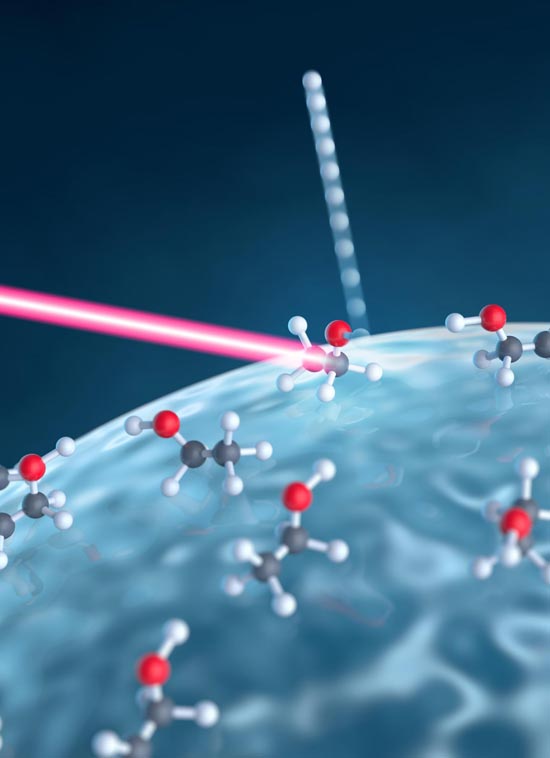An ultrafast glimpse of the photochemistry of the atmosphere

This is an ultrafast glimpse of the photochemistry of the atmosphere Credit: Matthias Kling
The nanocosmos is constantly in motion. All natural processes are ultimately determined by the interplay between radiation and matter. Light strikes particles and induces reactions.
By altering the energy states of electrons, it reshuffles atoms and causes molecules to be reconfigured. These processes are significantly accelerated when the reactants are absorbed on the surface of nanoparticles in the atmosphere.
This phenomenon is crucial for the photochemistry of the atmosphere and thus has an impact on our health and climate. One of the light-driven molecular processes that takes place on aerosols has now been investigated in detail by researchers led by Professor Matthias Kling and Dr. Boris Bergues at the Laboratory for Attosecond Physics, which is operated jointly by the LMU Munich and the MPQ.
The group has developed a new method, called reaction nanoscopy, which makes it possible to study elemental physicochemical transitions on solid interfaces. They have now used it to characterize the reaction of ethanol with water molecules on the surface of glass nanoparticles under the influence of high-intensity laser light. The researchers irradiated the spherical particles with ultrashort laser pulses, each lasting for a few femtoseconds.
A femtosecond is a millionth of a billionth of a second. With the aid of reaction nanoscopy, they were able to record this ultrashort interaction in three dimensions with nanometer resolution. “We have observed the detachment and acceleration of hydrogen ions from molecules on the surface of nanoparticles. The ability to do so forms the basis for the high spatial resolution of our imaging technique,” explains Boris Bergues.
“Because the technology enables us to determine the exact position on the nanoparticle with the highest reaction yield, we can trace reactions of molecules adsorbed on the surface of aerosols with high spatial resolution”, adds Matthias Kling. Such processes are ubiquitous, especially in the fields of atmospheric physics and astrochemistry.
For example, light in our atmosphere interacts with aerosols and their attached molecules, triggering subsequent reactions that may be important for the development of our climate. In the short term, the results obtained with the new analytical procedure by the Munich laser physicists may provide useful insights, especially in the field of atmospheric chemistry.
Media Contact
More Information:
http://dx.doi.org/10.1038/s41467-019-12580-0All latest news from the category: Physics and Astronomy
This area deals with the fundamental laws and building blocks of nature and how they interact, the properties and the behavior of matter, and research into space and time and their structures.
innovations-report provides in-depth reports and articles on subjects such as astrophysics, laser technologies, nuclear, quantum, particle and solid-state physics, nanotechnologies, planetary research and findings (Mars, Venus) and developments related to the Hubble Telescope.
Newest articles

NASA: Mystery of life’s handedness deepens
The mystery of why life uses molecules with specific orientations has deepened with a NASA-funded discovery that RNA — a key molecule thought to have potentially held the instructions for…

What are the effects of historic lithium mining on water quality?
Study reveals low levels of common contaminants but high levels of other elements in waters associated with an abandoned lithium mine. Lithium ore and mining waste from a historic lithium…

Quantum-inspired design boosts efficiency of heat-to-electricity conversion
Rice engineers take unconventional route to improving thermophotovoltaic systems. Researchers at Rice University have found a new way to improve a key element of thermophotovoltaic (TPV) systems, which convert heat…



